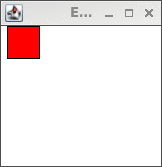我正在尝试使用Java和Swing制作2D游戏,但窗口刷新太慢了。但是,如果我移动鼠标或按键,窗口将以应有的速度刷新!这里有一个GIF,展示了当我移动鼠标时窗口如何快速刷新。
我已经搜索了几天网络,试图找到答案,但是似乎没有什么帮助!
代码
为什么窗口刷新速度这么慢?为什么鼠标和键盘会影响它的刷新率?如果可能的话,我该如何使其始终快速刷新?
背景信息
我使用 javax.swing.Timer 每 1/25 秒更新游戏状态,然后调用 repaint() 在游戏面板上重新绘制场景。
我知道计时器可能不总是延迟正好 1/25 秒。
我也知道调用 repaint() 只是请求立即重绘窗口,并不能立即重绘窗口。
我的显卡不支持 OpenGL 2+ 或硬件加速的 3D 图形,这就是为什么我不使用 libgdx 或 JME 进行游戏开发的原因。
系统信息
- 操作系统:Linux Mint 19 Tara
- JDK版本:OpenJDK 11.0.4
- 显卡:Intel Corporation 82945G/GZ
研究
这位Stack Overflow用户描述了我遇到的同样问题,但据说作者通过在单独的计时器上重复调用repaint()方法解决了该问题。我尝试过这种方法,确实可以使窗口刷新得更快,但即便如此,速度仍然比我想要的慢。在这种情况下,晃动窗口上的鼠标仍然可以提高刷新率。因此,似乎那篇文章并没有真正解决问题。
另一位Stack Overflow用户也遇到了这个问题,但他们在游戏循环中使用了一个连续的while循环,而不是计时器。显然,这位用户通过在while循环中使用Thread.sleep()方法解决了问题。然而,我的代码使用计时器来完成延迟,所以我不知道Thread.sleep()如何解决我的问题,或者我应该把它放在哪里。
我已经阅读了使用AWT和Swing绘画,试图弄清楚是否只是我误解了重绘的概念,但是那篇文章中没有任何内容能够为我阐明这个问题。每当游戏更新时,我调用repaint(),但是窗口只有在鼠标或键盘输入发生时才会快速刷新。我已经搜索了几天网络,试图找到答案,但是似乎没有什么帮助!
代码
import java.awt.Graphics;
import java.awt.Dimension;
import java.awt.Color;
import javax.swing.JFrame;
import javax.swing.JPanel;
import javax.swing.SwingUtilities;
import javax.swing.Timer;
class Game {
public static final int screenWidth = 160;
public static final int screenHeight = 140;
/**
* Create and show the GUI.
*/
private static void createAndShowGUI() {
/* Create the GUI. */
JFrame frame = new JFrame("Example");
frame.setDefaultCloseOperation(JFrame.EXIT_ON_CLOSE);
frame.setResizable(false);
frame.getContentPane().add(new GamePanel());
frame.pack();
/* Show the GUI. */
frame.setVisible(true);
}
/**
* Run the game.
*
* @param args the list of command-line arguments
*/
public static void main(String[] args) {
/* Schedule the GUI to be created on the EDT. */
SwingUtilities.invokeLater(() -> createAndShowGUI());
}
}
/**
* A GamePanel widget updates and shows the game scene.
*/
class GamePanel extends JPanel {
private Square square;
/**
* Create a game panel and start its update-and-draw cycle
*/
public GamePanel() {
super();
/* Set the size of the game screen. */
setPreferredSize(
new Dimension(
Game.screenWidth,
Game.screenHeight));
/* Create the square in the game world. */
square = new Square(0, 0, 32, 32, Square.Direction.LEFT);
/* Update the scene every 40 milliseconds. */
Timer timer = new Timer(40, (e) -> updateScene());
timer.start();
}
/**
* Paint the game scene using a graphics context.
*
* @param g the graphics context
*/
@Override
protected void paintComponent(Graphics g) {
super.paintComponent(g);
/* Clear the screen. */
g.setColor(Color.WHITE);
g.fillRect(0, 0, Game.screenWidth, Game.screenHeight);
/* Draw all objects in the scene. */
square.draw(g);
}
/**
* Update the game state.
*/
private void updateScene() {
/* Update all objects in the scene. */
square.update();
/* Request the scene to be repainted. */
repaint();
}
}
/**
* A Square is a game object which looks like a square.
*/
class Square {
public static enum Direction { LEFT, RIGHT };
private int x;
private int y;
private int width;
private int height;
private Direction direction;
/**
* Create a square game object.
*
* @param x the square's x position
* @param y the square's y position
* @param width the square's width (in pixels)
* @param height the square's height (in pixels)
* @param direction the square's direction of movement
*/
public Square(int x,
int y,
int width,
int height,
Direction direction) {
this.x = x;
this.y = y;
this.width = width;
this.height = height;
this.direction = direction;
}
/**
* Draw the square using a graphics context.
*
* @param g the graphics context
*/
public void draw(Graphics g) {
g.setColor(Color.RED);
g.fillRect(x, y, width, height);
g.setColor(Color.BLACK);
g.drawRect(x, y, width, height);
}
/**
* Update the square's state.
*
* The square slides horizontally
* until it reaches the edge of the screen,
* at which point it begins sliding in the
* opposite direction.
*
* This should be called once per frame.
*/
public void update() {
if (direction == Direction.LEFT) {
x--;
if (x <= 0) {
direction = Direction.RIGHT;
}
} else if (direction == Direction.RIGHT) {
x++;
if (x + width >= Game.screenWidth) {
direction = Direction.LEFT;
}
}
}
}

Timer timer = new Timer(40, (e) -> { SwingUtilities.invokeLater(() -> updateScene()); } );并查看问题是否仍然存在? - k5_paintImmediately。您可以通过在计时器上调用setCoalesce(true)来避免资源的过度消耗;正如您已经知道的那样,在update中应该考虑真正经过的时间。在这样的设置中,甚至可以在启动动画时在组件上调用setIgnoreRepaint(true),因为您知道会在合理的时间内进行更新。 - Holger